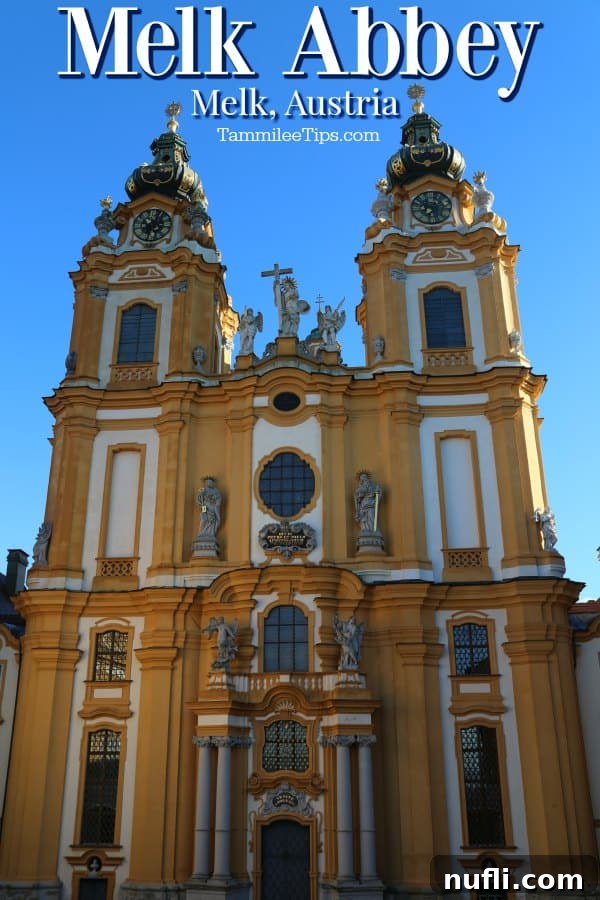The Danube River, a storied waterway weaving through the heart of Europe, offers countless opportunities for discovery and immersion in rich cultural heritage. During our memorable Vikings Castles & Legends cruise, one particular stop stood out as a beacon of history, art, and enduring faith: the magnificent Melk Abbey. Perched majestically above the charming town of Melk and overlooking the scenic expanse of the Wachau Valley, this Benedictine monastery is not merely a historical building, but a vibrant cultural center that has captivated visitors for centuries. Our visit, departing directly from the comfort of the Viking Vili, promised an immersive guided tour, a unique chance to step back in time and witness the grandeur of one of Austria’s most treasured landmarks.
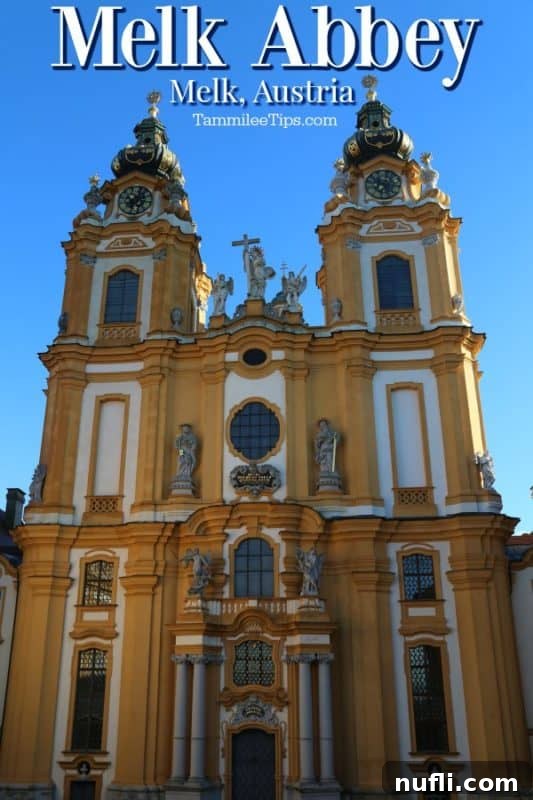
Short on time? Here’s a quick guide to planning your Melk adventure:
🏨 Find the best hotels and vacation rentals in Melk and nearby regions.
📍 Explore highly-rated tours and activities for an unforgettable visit to Melk Abbey.
Melk Abbey: A Timeless Legacy and UNESCO Treasure in Melk, Austria
Melk Abbey stands as a monumental testament to European history and unwavering religious devotion, rightfully designated a UNESCO World Cultural Heritage Site. Its significance extends far beyond its opulent Baroque facade; it is a living institution, continuously inhabited and shaped by Benedictine monks since 1089. This incredible continuity, spanning over nine centuries, makes Melk Abbey a unique cultural treasure, embodying the enduring spirit of monastic life, scholarship, and artistic patronage that has profoundly influenced Austrian and European history.
The Abbey complex we admire today, a striking vision of golden yellow and intricate architectural detail, was meticulously constructed between 1702 and 1736. This ambitious project was the brainchild of the brilliant master-builder Jakob Prandtauer, who transformed the earlier medieval monastic complex into the resplendent Baroque masterpiece we see today. Prandtauer’s design is a triumph of harmony and grandeur, characterized by its imposing scale, theatrical flair, and the masterful integration of architecture, painting, and sculpture. Every archway, every fresco, and every statue tells a story, inviting visitors to delve into a past rich with spiritual and artistic endeavor. The sheer scale and beauty of the Abbey, dramatically positioned on a rocky outcrop, truly define the landscape of the Wachau Valley.
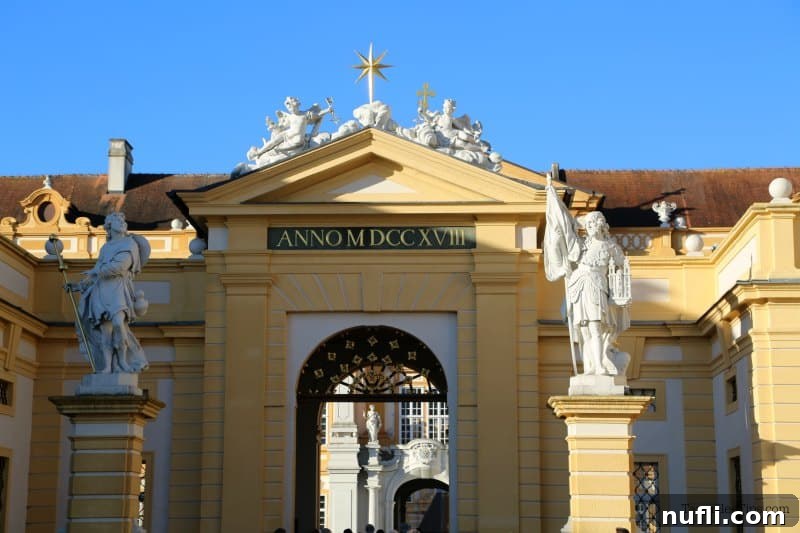
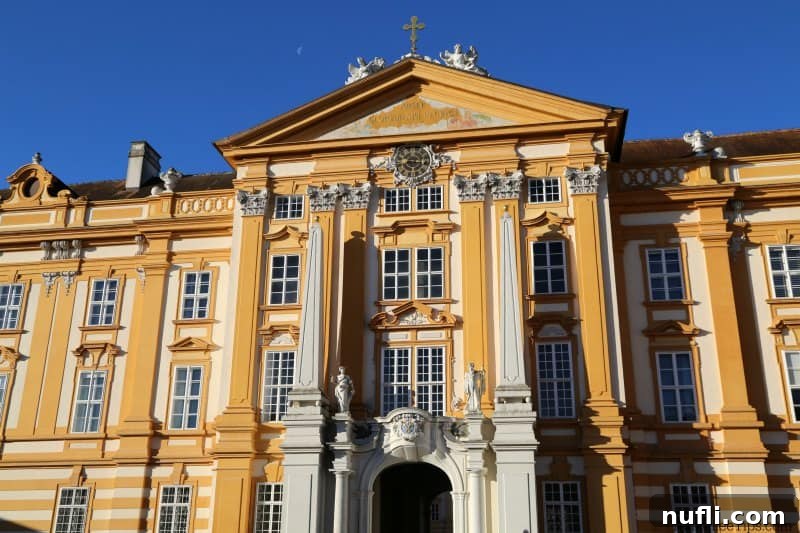
Journey Through Time: The Abbey Museum and Imperial Rooms Experience
Our guided tour commenced in the former Imperial Rooms, which now house the captivating Abbey Museum. The exhibition, aptly titled “The Path from Yesterday to Today,” offers a fascinating and thought-provoking exploration of Melk Abbey’s extensive 900-year history. This is no ordinary historical display; it’s an innovative fusion of ancient artifacts and contemporary design. Imagine centuries-old relics, priceless antiques, and religious vestments illuminated by modern lighting, presented in interactive settings that bridge the gap between historical reverence and modern storytelling. The curators have truly excelled in creating an experience that is both profoundly educational and deeply engaging, making complex history accessible to all.
Through a series of artfully conceived installations, visitors are taken on a chronological journey. The narrative unfolds with dynamic light changes, subtle shifts in floor textures, and multimedia elements that bring pivotal moments in the Abbey’s history to life. From its founding as a Babenberg fortress in the 11th century to its transformation into a spiritual and intellectual powerhouse during the Baroque era, the exhibition adeptly communicates the monks’ unwavering commitment to learning, faith, and cultural preservation. It’s a testament to how an institution can adapt and thrive through successive eras, facing challenges and triumphs, all while maintaining its core spiritual and educational mission.
One of the striking aspects of the interior visit is the absence of photography in many of the Abbey’s most sacred and historically significant areas. Due to unfortunate instances of disrespectful behavior by a minority of tourists, the Abbot made the difficult but understandable decision to prohibit photos inside. While initially, this might seem disappointing to eager photographers, it ultimately serves as a powerful reminder to truly be present and absorb the profound beauty and spiritual atmosphere. Without the distraction of capturing the perfect shot, one is encouraged to fully appreciate the intricate details of the frescoes, the sheer grandeur of the architecture, and the palpable sense of history that permeates every hall, fostering a more mindful and respectful engagement with the site.
Architectural Grandeur: The Marble Hall and the World-Renowned Library
Our knowledgeable guide expertly led us through the Imperial Rooms, providing rich context and fascinating anecdotes, before ushering us into the breathtaking Marble Hall. This magnificent chamber, once the opulent banqueting hall for emperors and distinguished guests, is an absolute marvel of Baroque artistry. Its walls are not of real marble, but are instead adorned with stunning faux marble, skillfully painted by Antonio Beduzzi to mimic real stone, creating an illusion of opulent luxury and boundless space. The ceiling frescoes, painted by the celebrated Paul Troger, depict allegorical scenes that glorify wisdom and divine providence, inviting contemplation as much as admiration. Standing in this grand hall, one can almost hear the echoes of past festivities, important diplomatic gatherings, and intellectual debates, a vibrant reminder of the Abbey’s historical role beyond just spiritual retreat.
From the splendor of the Marble Hall, our journey continued into the world-renowned Abbey Library. This is perhaps one of the most iconic images associated with Melk Abbey, an architectural and intellectual treasure trove of unparalleled significance. While photography was strictly prohibited here as well, the memory of its magnificence remains vivid and etched in the mind. Tier upon tier of ancient texts, many bound in rich, aged leather, line towering shelves that reach towards the heavens, creating an atmosphere of profound scholarship. The library is not merely a storage facility but a living testament to the Benedictine tradition of scholarship, a dedication to the preservation of knowledge, and the advancement of learning through the ages. It houses an extraordinary collection of medieval manuscripts, priceless incunabula (early printed books from the 15th century), and countless volumes covering theology, philosophy, history, natural sciences, and more. Today, the library continues its vital role, serving as an active research institution, ensuring that the legacy of learning and intellectual inquiry thrives.
The Abbey’s deep commitment to education extends further, with a prominent school operating on-site. This remarkable continuity from ancient monastic schools, which were instrumental in preserving knowledge during the Middle Ages, to modern educational institutions underscores the Benedictine dedication to fostering intellectual growth and contributing significantly to society. Witnessing this blend of ancient tradition and contemporary relevance truly brings the Abbey’s centuries-long story to life, showcasing its enduring impact on culture and education.
The Spiritual Heart: Melk Abbey Church
No visit to Melk Abbey, regardless of the tour’s specific route, would be complete without acknowledging its profound spiritual heart: the Abbey Church. This awe-inspiring example of High Baroque architecture is a sanctuary of unparalleled beauty and grandeur, a masterwork of religious art and design. Designed primarily by Prandtauer and adorned by renowned masters such as Johann Michael Rottmayr (responsible for the breathtaking ceiling frescoes) and Antonio Galli Bibiena (who contributed to the dramatic altar design), the church is a symphony of shimmering gold, vibrant colors, and intricate stucco work. The central dome soars majestically above, featuring Rottmayr’s masterful fresco depicting the “Glory of the Angels,” effortlessly drawing the eye upwards towards divine inspiration and celestial splendor.
The main altar, a dramatic sculptural masterpiece, commands central attention, symbolizing the core of Benedictine worship. Numerous side altars, exquisitely decorated chapels, and ornate confessionals contribute to the overwhelming sense of devotion and artistry that fills the space. Every surface, from the polished marble columns to the intricate carvings, seems to tell a story, reflecting the fervent religious spirit and artistic innovation of the Baroque era. Stepping inside, one is immediately enveloped by an atmosphere of reverence and wonder, a truly profound experience that transcends mere architectural appreciation and offers a glimpse into centuries of faith.
A Hidden Gem: The Exquisite Spiral Staircase
As our guided tour neared its conclusion, a delightful architectural surprise awaited us: the exquisite spiral staircase. I must confess, this was one of the elements I was most eager to see, having heard whispers of its unique beauty. I managed to capture a few discreet photos at a point where no signs explicitly prohibited it, a small act of rebellion in the face of the no-photo policy, driven by pure admiration. This architectural marvel is not just a functional ascent or descent but a work of art in itself. The underside of the staircase is adorned with gorgeous paintings, creating an ingenious optical illusion that is both playful and captivating. It’s a masterful example of Baroque artistry designed to surprise and delight the viewer, playing skillfully with perspective, light, and form.
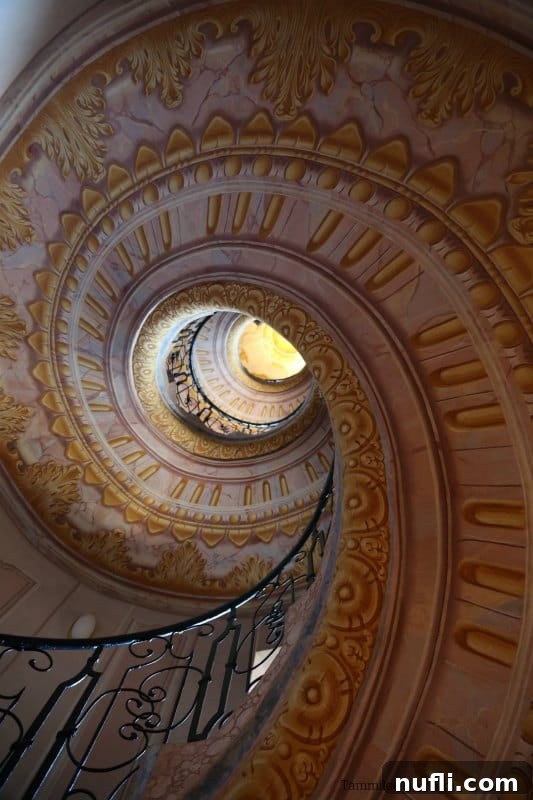
My advice to future visitors is simple: make sure to look up when you descend this particular staircase! It’s a moment of unexpected beauty and artistic brilliance that perfectly encapsulates the theatricality and hidden wonders often found in Baroque design. This unexpected discovery provided a memorable flourish to our comprehensive tour of the Abbey’s magnificent interior, leaving a lasting impression of the intricate thought behind every detail.
Exploring the Abbey Grounds and Beyond: Seasonal Delights
Emerging from the historical interiors, we found ourselves back in the grand courtyards, which offer sweeping views of the surrounding complex and the picturesque landscape. The Abbey is a self-contained world, comprising multiple wings, serene courtyards, and expansive terraces. Even though our November visit meant some outdoor areas were closed for the winter season, the sheer scale and architectural harmony of the exterior were still deeply impressive. The iconic golden facade of the main building, visible from afar across the river, glows majestically, asserting its dominance over the landscape. From various vantage points within the Abbey grounds, one can truly appreciate its strategic position overlooking the Danube River and the picturesque Wachau Valley – a UNESCO-protected landscape renowned globally for its terraced vineyards, charming villages, and stunning natural beauty.
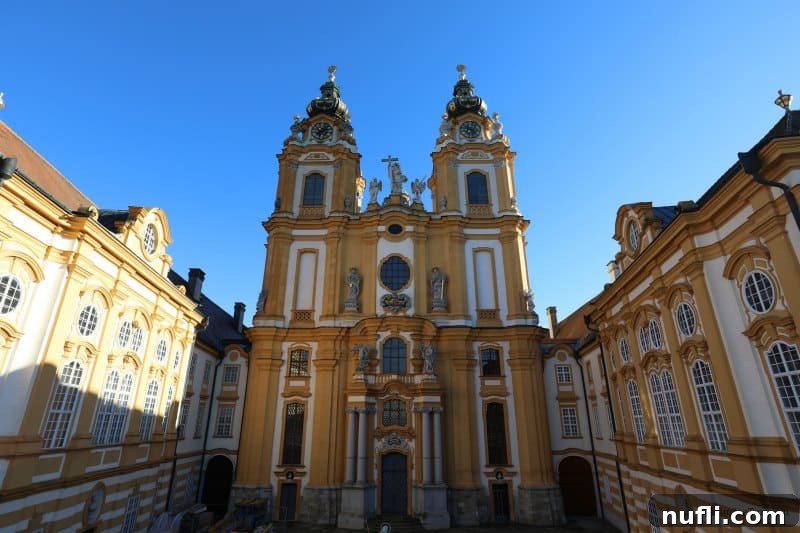
For those fortunate enough to visit between May and October, the Abbey Park and the exquisite Baroque Garden Pavilion offer another delightful layer of exploration. The park is a serene oasis, meticulously designed in the formal Baroque style, perfect for a leisurely stroll amidst manicured hedges, fragrant flowers, and tranquil fountains. The pavilion itself, a charming architectural folly, often hosts temporary exhibitions or cultural events, adding to the visitor experience. These expansive outdoor areas provide a wonderful contrast to the interior grandeur, allowing one to appreciate the Abbey’s integrated design and its harmonious relationship with the surrounding natural environment, making it a truly holistic experience.

Treasures and Souvenirs from Melk: Supporting a Living Tradition
No visit to a place of such profound historical and cultural richness would be complete without a stop at the Abbey’s thoughtfully curated gift shop, and Melk Abbey’s offers something truly special and authentic. Here, visitors have the unique opportunity to purchase souvenirs that are deeply connected to the Abbey’s ongoing monastic life and the agricultural bounty of the surrounding region. Keep a keen eye out for the unique range of products lovingly crafted by the Benedictine monks themselves, or produced under their direct supervision, embodying a tradition of monastic craftsmanship that spans centuries and contributes to the Abbey’s self-sufficiency.
Among the treasures you might find are local wines and liqueurs, many produced from the fertile lands surrounding the monastery, particularly from the renowned Wachau Valley vineyards, famous for their Grüner Veltliner and Riesling. Also look for delectable apricot juice and jams, a highly prized regional specialty for which the Wachau is world-famous, along with pure honey sourced from the Abbey’s own bees and artisanal chocolates. Each purchase not only provides a lovely, meaningful memento of your visit but also directly supports the continued preservation, vital work, and charitable endeavors of Melk Abbey and its monastic community. It’s a wonderful way to take a piece of Austrian history, monastic tradition, and regional flavor home with you, knowing you’ve contributed to its enduring legacy.
Planning Your Danube River Cruise and Austrian Adventures
Our visit to Melk Abbey was undoubtedly a highlight of our Vikings Castles & Legends cruise, offering a profound insight into Austria’s rich heritage and the enduring power of faith and art. A Danube River cruise provides an unparalleled and incredibly convenient way to experience such historical gems, combining luxurious travel with seamless access to incredible cultural sites without the hassle of daily packing and unpacking.
If you’re planning your own journey through this enchanting region, consider exploring other fascinating stops along the way. The Danube is dotted with historical cities, charming towns, and breathtaking landscapes waiting to be discovered. Here are some additional articles from our Viking River Cruise experiences that might inspire and inform your itinerary, helping you craft your perfect Austrian adventure:
- A harmonious journey: The Sound of Music Tour in Salzburg, Austria
- Scenic wonders: Sailing the Wachau Valley with Viking River Cruises in Austria
- Festive delights: Exploring the magical Salzburg Christmas Market
- Setting sail: What to expect when boarding the Viking Vili for your Castles & Legends cruise
- Urban exploration: A comprehensive Munich City Tour with Viking River Cruises
For a complete overview and even more inspiration for your next European river cruise, be sure to check out all of our dedicated Viking River Cruise Travel Guides, filled with tips, insights, and personal experiences.
Disclaimer: Our visit to Melk Abbey was part of a hosted trip with Viking River Cruises. All opinions and insights expressed in this article are entirely our own, reflecting our genuine experience and deep appreciation for this truly remarkable destination.
